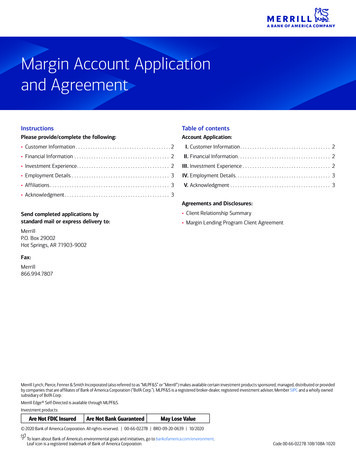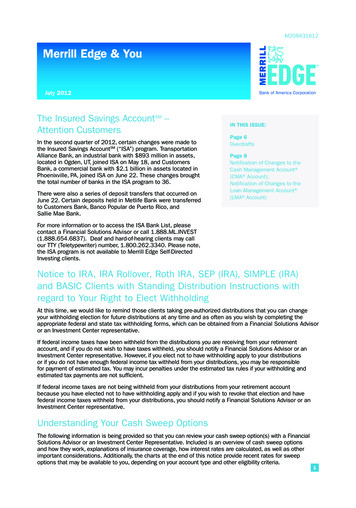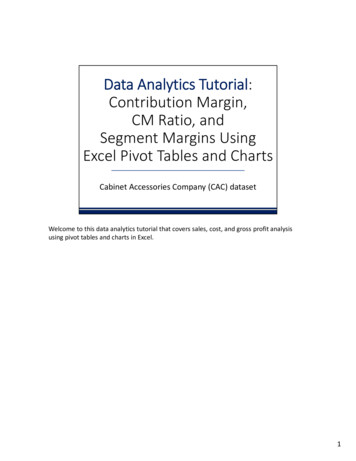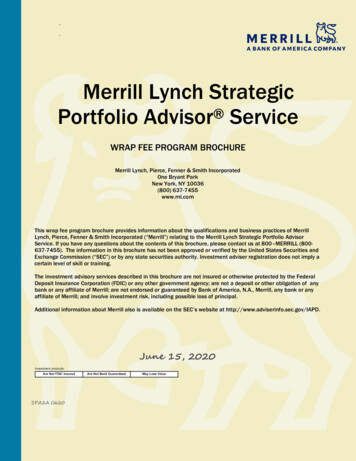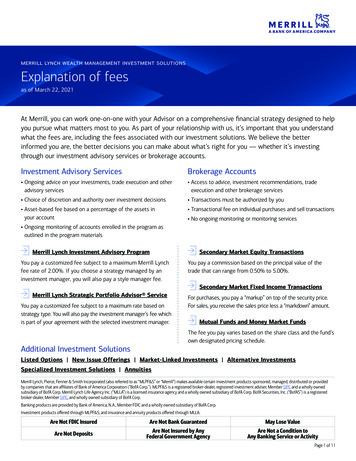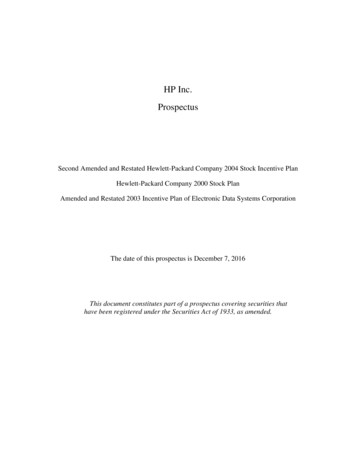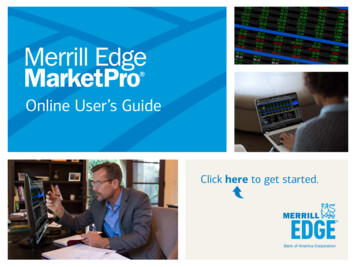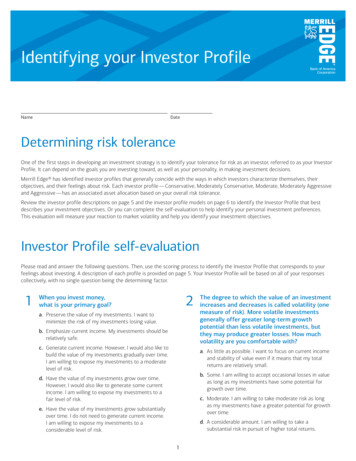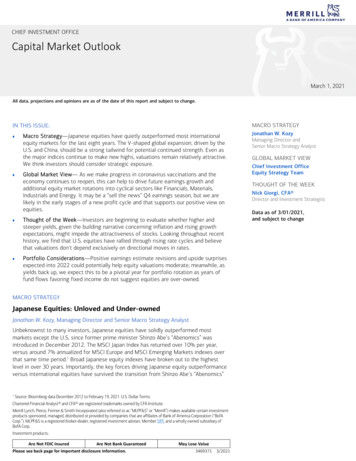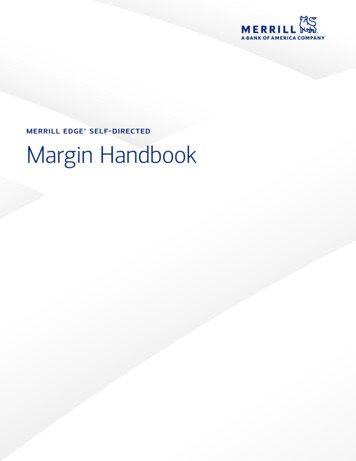
Transcription
merrill edge self-directedMargin Handbook
Margin Risk Disclosure StatementIn accordance with requirements of FINRA, Merrill is furnishing this Margin Risks Disclosure Statement. This document will provide some basic information aboutpurchasing securities on margin and alert you to the risks involved with maintaining a margin account. Merrill refers to margin as the margin lending program. Whenyou purchase securities, you may pay for the securities in full, or if your account has been established as a margin account with the margin lending program, you mayborrow part of the purchase price from Merrill, thereby leveraging your investment. If you choose to borrow funds for your purchase, Merrill’s collateral for the loan willbe the securities purchased, other assets in your margin account and your assets in any other accounts at Merrill other than retirement accounts (such as IRAs). If thesecurities in your margin account decline in value, so does the value of the collateral supporting your loan, and, as a result, we can take action, such as to issue a margincall and/or sell securities in any of your accounts held with us, in order to maintain the required equity in your account. If your account has a Visa card and/or checks,you may also create a margin debit if your withdrawals (by Visa card, checks, preauthorized debits, FTS or other transfers) exceed the sum of any available free creditbalances plus available money account balances (such as bank deposit balances or money market funds). Please refer to your account documents for more information.Also note that it may be more advantageous to pay cash than to use margin for smaller securities purchases. On smaller securities purchases, a higher percentageof the transaction cost goes to commissions and interest charges, which are generally higher on smaller balances. The commissions plus interest charges couldequal or exceed any appreciation in your securities. Before opening a margin account, you should carefully review the terms governing margin loans. For IndividualInvestor Accounts, these terms are contained in the Margin Lending Program Client Agreement. For all other accounts, the terms are in your account agreement anddisclosures. It is important that you fully understand the risks involved in using margin. These risks including the following: You can lose more funds than you deposit in the margin account. A decline in the value of securities that are purchased on margin may require you to provideadditional funds to us to avoid the forced sale of those securities or other securities or assets in your account(s). We can force the sale of securities or other assets in your account(s). If the equity in your account falls below the maintenance margin requirements or Merrill’shigher “house” requirements, we can sell the securities or other assets in any of your accounts held by us to cover the margin deficiency. You alsowill be responsible for any shortfall in the account after such a sale. We can sell your securities or other assets without contacting you. Some investors mistakenly believe that they must be contacted for a margin call to be valid,and that securities or other assets in their accounts cannot be liquidated to meet the call unless they are contacted first. This is not the case. We will attempt tonotify you of margin calls, but we are not required to do so. Even if we have contacted you and provided a specific date by which you can meet a margin call, we canstill take necessary steps to protect our financial interests, including immediately selling the securities or other assets without notice to you. You are not entitled to choose which securities or other assets in your account(s) are liquidated or sold to meet a margin call. Because the securities orother assets are collateral for the margin loan, we have the right to decide which securities or other assets to sell in order to protect our interests. We can increase our “house” maintenance margin requirements at any time and are not required to provide you advance written notice. These changesin our policy may take effect immediately and may result in the issuance of a maintenance margin call. Your failure to satisfy the call may cause us to liquidate or sellsecurities in your account(s). You are not entitled to an extension of time on a margin call. While an extension of time to meet margin requirements may be available to you under certainconditions, you do not have a right to the extension.If you have any questions or concerns about margin and the margin lending program, please contact the Merrill Edge Self-Directed Investment Center.Important InformationPlease remember there’s always the potential of losing money when investing in securities. The following information isintended for Merrill Edge Self-Directed clients to learn more about margin trading rules and requirements, especially for trades enteredonline through merrilledge.com. Merrill Edge Self-Directed clients may contact the Investment Center at 877.653.4732 with questionsabout the Merrill Edge Margin Handbook.This handbook contains information, terminology and requirements associated with margin trading at Merrill. As a Merrill EdgeSelf-Directed client, you will have access to your accounts and, if approved, be permitted to enter margin trades online. We believe youshould have a basic understanding of margin prior to entering trades involving the extension of credit. Please note that the examplescontained in this handbook do not include commissions, margin interest, account fees or any other fees associated with yourMerrill Edge Self-Directed account.Merrill Lynch, Pierce, Fenner & Smith Incorporated (also referred to as “MLPF&S” or “Merrill”) makes available certain investment products sponsored, managed,distributed or provided by companies that are affiliates of Bank of America Corporation (“BofA Corp.”). MLPF&S is a registered broker-dealer, Member SIPC and awholly owned subsidiary of BofA Corp.Banking products are provided by Bank of America, N.A., and affiliated banks, Members FDIC and wholly owned subsidiaries of BofA Corp.Investment products:Are Not FDIC InsuredAre Not Bank GuaranteedMay Lose Value 2019 Bank of America Corporation. All rights reserved. ARWHNT6B BRO-06-19-0196 07/2019
Table of ContentsMargin Basics . . . . . . . . . . . . . . . . . . . . . . . . . . . . . . . . . . . . 1What Is Margin? . . . . . . . . . . . . . . . . . . . . . . . . . . . . . . . 1Cash vs . Margin Accounts . . . . . . . . . . . . . . . . . . . . . . 2Advantages and Risks of Using Margin . . . . . . . . . . . 3Short Selling . . . . . . . . . . . . . . . . . . . . . . . . . . . . . . . . . . 4Securities Eligible for Margin . . . . . . . . . . . . . . . . . . . 6Margin Requirements . . . . . . . . . . . . . . . . . . . . . . . . . . . . 8Equity Margin Values . . . . . . . . . . . . . . . . . . . . . . . . . . . 8Stock/ETF Margin Requirements . . . . . . . . . . . . . . . 12Concentrated Equity Requirements . . . . . . . . . . . . . 13Fixed Income Margin Requirements . . . . . . . . . . . . 14Margin Calls . . . . . . . . . . . . . . . . . . . . . . . . . . . . . . . . . . 14Satisfying Margin Calls . . . . . . . . . . . . . . . . . . . . . . . . 14Day Trading . . . . . . . . . . . . . . . . . . . . . . . . . . . . . . . . . . . . . 15What Is Day Trading? . . . . . . . . . . . . . . . . . . . . . . . . . . 15Day Trading Requirements . . . . . . . . . . . . . . . . . . . . . 15Day Trade Call . . . . . . . . . . . . . . . . . . . . . . . . . . . . . . . . 17Trading Violations . . . . . . . . . . . . . . . . . . . . . . . . . . . . . . . 18Overview . . . . . . . . . . . . . . . . . . . . . . . . . . . . . . . . . . . . 18Freeriding Violation . . . . . . . . . . . . . . . . . . . . . . . . . . . 18Technical Violation (Cash) . . . . . . . . . . . . . . . . . . . . . . 19Technical Violation (Margin) . . . . . . . . . . . . . . . . . . . . 19Sale-Not-Long Violation . . . . . . . . . . . . . . . . . . . . . . . 20Unmet Day Trade Call . . . . . . . . . . . . . . . . . . . . . . . . . 20Restrictions . . . . . . . . . . . . . . . . . . . . . . . . . . . . . . . . . . 20FAQs . . . . . . . . . . . . . . . . . . . . . . . . . . . . . . . . . . . . . . . . . . . . 21Important Margin Definitions . . . . . . . . . . . . . . . . . . . 22
Margin RequirementsMargin BasicsWhat Is Margin? Cash vs. Margin AccountsDay Trading Trading ViolationsAdvantages and Risks of Using Margin FAQsImportant Margin DefinitionsSecurities Eligible for MarginMargin BasicsWhat Is Margin?A margin account is a loan account . Margin is an extension of credit by Merrill using marginable securities held as collateralYou can use margin loans to purchase additional securities or withdraw funds for other purposes . Margin accounts can alsobe used for short selling securities . Merrill refers to margin as the Margin Lending Program .Margin interest is charged on the amount of money you borrow based on how much time the loan is outstanding . Margininterest rates are based on your total loan amount and are subject to change . Current margin rates are available onlineThe amount of money that can be borrowed and the terms of the Margin Lending Program are governed by the Board ofGovernors of the Federal Reserve System, the Securities and Exchange Commission (SEC), the Financial Industry RegulatoryAuthority (FINRA) and Merrill .To be considered for a margin account, you must apply at account opening or separately using the Margin Lending ProgramApplication and Agreement and maintain at least 2,000 in equity through the deposit of cash or marginable securities .After you have met the minimum requirements, initial equity will be based on the Regulation T (Reg T) requirement, whichis currently 50% of the purchase price of most securities . This means that if you wish to purchase 15,000 of a marginablesecurity, you could pay 7,500 and borrow the remaining 7,500 from Merrill . You will be charged margin interest on theamount you borrow .After the initial requirements have been met, certain minimum maintenance equity requirements apply to margin accounts .Merrill generally applies a maintenance requirement equal to 30% of the current market value, in the case of fullymarginable equity securities .Requirements change based on the types of positions held in the account .Please note that margin requirements are based on the market value of a security . Therefore, a decline in the price may result ina higher maintenance requirement for the position and may subsequently create a maintenance call in the account . Securitiesthat fall below certain dollar thresholds are subject to higher maintenance margin requirements . (See Stock/ETF MarginRequirements)If the value of positions purchased on margin decreases and the equity of your account falls below certain minimummaintenance thresholds, you will be required to meet a margin call by either selling securities in your account or depositingcash or additional marginable securities .1
Margin BasicsWhat Is Margin?Margin RequirementsCash vs. Margin Accounts Day TradingTrading ViolationsAdvantages and Risks of Using Margin FAQsImportant Margin DefinitionsSecurities Eligible for MarginCash vs . Margin AccountsBoth cash and margin accounts allow you to purchase securities, but they differ in how you can pay for securities and thetypes of trades allowed . Cash accounts require that purchases are paid in full, while margin accounts will allow you to borrow aportion of the total purchase cost .Cash AccountMargin Account All trades in a cash account are paid in full by thesettlement date . A margin account is a loan account where you can leverageyour eligible investments . If full payment is not made by due date, Merrill is requiredto liquidate (sell) the security and your account may besubject to a trading violation and restriction . Please seeTrading Violations for more information . Trades in a margin account may be paid in full by thesettlement date, or an extension of credit by Merrill maybe used to cover trade requirements, as long as sufficientmargin equity is available in your account . Money market mutual funds held in the account willredeem on settlement date . Money market mutual funds held in the account will redeemon settlement date . If the account is in a Maintenancecall, the funds will be automatically redeemed to coverthe incremental call on the due date (origin date 2) . Free riding is not permitted (buying and selling thesame security and using the sale proceeds to pay forthe transaction without otherwise having funds topay for the trade . Sales in a cash account should not take place unless thesecurity is paid in full . Short sales and extended settlements are not permitted . Withdrawals are limited to the amount of settled cashheld in the account . The extension of credit through the Margin LendingProgram permits you to make partial payment toward youropening trade and borrow the remainder from Merrill . Market fluctuations may create situations where youare required to bring in additional funds or marginablesecurities to cover a margin call If required payment is not made by due date, Merrill mustliquidate (sell) securities and your account may be subjectto a trading violation and restriction . Please see TradingViolations for more information . Short sales, extended settlement trades and other tradesthat require margin are permitted . Withdrawals are limited to the amount of settled cashheld in your account plus the available loan value ofmarginable securities .2
Margin RequirementsMargin BasicsWhat Is Margin? Cash vs. Margin AccountsTrading ViolationsDay TradingAdvantages and Risks of Using Margin FAQsImportant Margin DefinitionsSecurities Eligible for MarginAdvantages and Risks of Using MarginAdvantage: A margin account can increase your profit potential by leveraging your marginable securities . You can alsoearn more profits/dividends by purchasing additional securities on credit .Example of a profitable trade in a cash and margin account:Let’s assume that you wish to invest 5,000 in ABC Corporation, which is currently trading at 50 per share .In a Cash AccountIn a Margin Account Buy 100 shares of ABC @ 50 for 5,000 Buy 200 shares of ABC @ 50 for 10,000 Minimum deposit: 5,000 Minimum deposit: 5,000 Borrow from Merrill: 5,000Now let’s assume the price of ABC Corporation rises by 20% to 60 per share .In a Cash AccountIn a Margin Account Your investment of 100 shares of ABCis worth 6,000 Your investment of 200 shares of ABCis worth 12,000 Profit: 1,000 less any commissions Profit: 2,000 less any commissions and interest– 5,000 DebitPurchase Costs– 10,000 DebitPurchase Costs 6,000 CreditSale Proceeds 12,000 CreditSale Proceeds 1,0003Profit 2,000ProfitContinued next page
Margin RequirementsMargin BasicsWhat Is Margin? Cash vs. Margin AccountsDay TradingTrading ViolationsAdvantages and Risks of Using Margin FAQsImportant Margin DefinitionsSecurities Eligible for MarginAdvantages and Risks of Using Margin (continued)Risk: Potential losses are significantly greater due to leverage if there is adverse market movement .Example of potential losses in declining markets:Let’s assume that you wish to invest 5,000 in ABC Corporation, which is currently trading at 50 per share .In a Cash AccountIn a Margin Account Buy 100 shares of ABC @ 50 for 5,000 Buy 200 shares of ABC @ 50 for 10,000 Minimum deposit: 5,000 Minimum deposit: 5,000 Borrow from Merrill: 5,000Now let’s assume the price of ABC Corporation falls by 20% the following business day to 40 per share .In a Cash AccountIn a Margin Account Your investment of 100 shares of ABC is worth 4,000 Your investment of 200 shares of ABC is worth 8,000 Loss: 1,000 less any commissions Loss: 2,000 less any commissions and interest– 5,000 DebitPurchase Costs 4,000 CreditSale Proceeds 1,000– 10,000 Debit 8,000Credit 2,000LossLossPurchase CostsSale ProceedsShort SellingShort selling is the practice of borrowing a security from Merrill and selling in anticipation that its market value will decline .You are only permitted to short sell in a margin account . Merrill must locate shares to borrow in order to facilitate short selling,and in some cases an order cannot be accepted because shares in a particular company may not be available to borrow .Advantage: You can realize a profit if the security sold decreases in value and you buy it back at a lower price .Example of a profitable short sale in a margin account:Let’s assume that you think the price of ABC Corporation will fall, and it is currently trading at 50 per share .Day 1Day 2 Sell short 100 shares of ABC @ 50 for 5,000 Buy 100 shares of ABC @ 40 for 4,000 to coverthe short positionThe following business day the price of ABC Corporationfalls by 20% to 40 per share . Profit: 1,000 less any commissions and interest 5,000 Credit– 4,000 Debit 1,0004Short Sale ProceedsBuy to Cover CostsProfitContinued next page
Margin BasicsWhat Is Margin? Margin RequirementsCash vs. Margin AccountsDay TradingTrading ViolationsAdvantages and Risks of Using Margin FAQsImportant Margin DefinitionsSecurities Eligible for MarginAdvantages and Risks of Using Margin (continued)Risk: Potential loss on a short sale is unlimited because there is no upward limit on the price of stockExample of potential losses in rising markets:Let’s assume that you think the price of ABC Corporation willfall and it is currently trading at 50 per share .After you short the stock, the price of ABC Corporationrises to 70 per share the next business dayDay 1Day 2 Sell short 100 shares of ABC @ 50 for 5,000 Buy 100 shares of ABC @ 70 for 7,000 tocover the short position Loss: 2,000 less any commissions and interest 5,000 Credit– 7,000 DebitShort Sale ProceedsBuy to Cover Costs 2,000 LossRisk: Because selling a security short requires you to borrow the security, it may become in demand, due to market conditions,and you may be required to cover the short positionYou may also be subject to stock borrow charges when borrowing securities in connection with short sales .Important Notice Regarding Short Selling SecuritiesPlease note: Merrill cannot guarantee that we will be able to continue to lend the securities that were sold short for more thanthe day on which the short sale is made . If Merrill cannot continue to lend the securities to you, we must require that you coverthe short sale . This may occur at an inopportune time, requiring you to buy shares at an unfavorable price and creating a loss .If the issuer of the securities that are sold short declares a dividend, issues warrants or rights, or engages in a merger or othertransaction that results in the issuer’s shareholders receiving cash or other securities, your account as the short seller will becharged accordingly . You will be required to repay all cash and to return all securities so distributed .5
Margin RequirementsMargin BasicsWhat Is Margin? Cash vs. Margin Accounts Day TradingTrading ViolationsAdvantages and Risks of Using MarginFAQsImportant Margin DefinitionsSecurities Eligible for MarginSecurities Eligible for MarginEquities: Sto
Margin Risk Disclosure Statement In accordance with requirements of FINRA, Merrill is furnishing this Margin Risks Disclosure Statement
